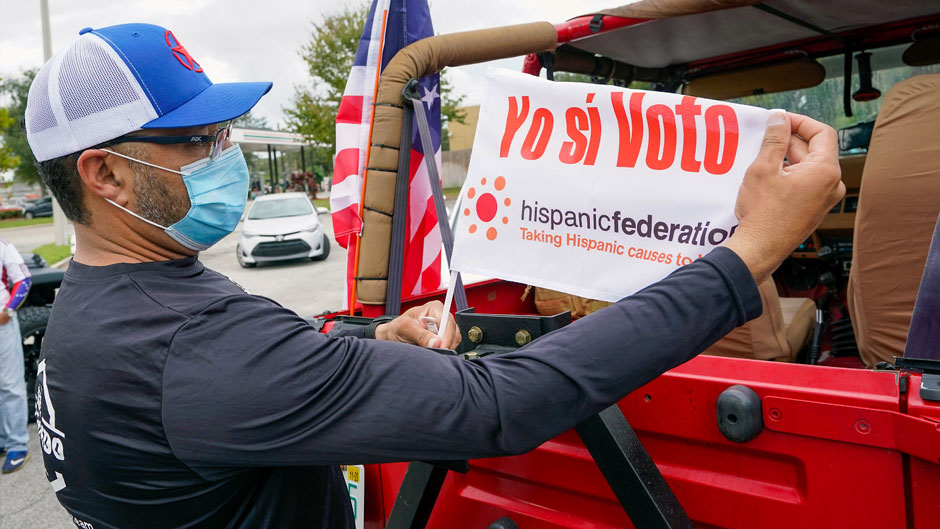For years, the Hispanic vote was called a “sleeping giant” that one day would wake up and be a force mostly favoring the Democratic Party.
The 2020 presidential campaign proved that the giant woke up—but not in the way many expected.
Hispanics now make up the largest minority group in the United States, and they voted strongly in the election contributing to major victories in some states including Florida and Arizona.
But Hispanics’ participation showed that they are not a monolithic group, and not all favor the Democratic Party, University of Miami political science experts say. Thirty percent of Hispanics voted for President Donald Trump.
“There are many qualities that unite the Hispanic community and we share cultural and ethnic characteristics,” said Fernand Amandi, political science lecturer and pollster. “But just like with any other group, there are differences and nuances that vary from state to state, country of birth, language dominance, and even generations.”
Hispanic voters’ concerns based on their country of origin played out quite dramatically in two parts of the country, said Michael Touchton, associate professor of political science.
The most striking example was Florida’s going red for the Republicans. The win was bolstered by 57 percent of the Cuban American electorate voting for Trump, while 41 percent of the same group voted for former Vice President Joe Biden in Miami Dade County.
“The accusation of socialism used against democrats worked very well in South Florida,” said Touchton. Many Cuban Americans and Venezuelan voters turned against the Democratic Party, fearing that democrats would lead them into a form of government they had fled in their homelands.
In Texas, Biden did well in large cities like Houston and San Antonio but also lost ground among Mexican American voters in the Rio Grande Valley. Many of them voted for Trump liking the message Republicans had touted of being tough on crime, experts said.
“The strong law-and-order message is what draws many of Latinos living near the Texas border to the Republican Party,” said Touchton. “They see images in major cities of burning cars, and that is enough to turn off law-and-order voters even if the economic and immigration policies that the democrats have is attractive.”
Even in Central Florida, the residence of most of the state’s Puerto Rican population, which tends to be democratic, Trump did better than Hillary Clinton in the 2016 presidential election, said Touchton. In 2020, he received about 30 percent of the votes from the Puerto Rican electorate, according to NBC exit polls.
Puerto Rican men in particular showed a significant preference for Trump, said Touchton.
“The possibility that the caudillo [strongman] image is driving voters may not be the main cause, but it plays a role,” he said. “Trump is someone who postures as an authoritarian, and some voters like it.”
In Arizona, Latinos helped Biden take the state, especially in large counties like Maricopa County, where Phoenix is located, and Pima County, home of Tucson, said Touchton. The state had been traditionally Republican and—although by a narrow margin—it flipped in part because of the Latino vote, he said.
One surprise in the election was the role played by Latinos in Wisconsin, where they make up about 7 percent of the electorate. While final numbers are not available, early exit polls revealed that some 46,000 Hispanics cast early votes in the state—up from 17,000 in 2016. The newly registered Latino voters are overwhelmingly Democrats, said Touchton. They are very likely to have played a role in flipping the state blue.
Overall, the election has highlighted that the Latino vote is complex and not tied to one issue, said Touchton. These voters have a wide variety of issues that interest them, beyond immigration and education.
“This puts them much more in line with the rest of the American electorate,” he said. It also gives both parties room for reflection on how to campaign in the diverse Hispanic communities, he added.
According to Touchton, campaigns need to hire “local champions” who are well-known in the community and can fashion local messaging that resonates with each ethnic group. They should also maintain a connection to those communities.
In Miami Dade County, the Republican party had a persistent campaign and Trump visited the area several times, including one visit where he sat in a meeting with Cuban American and Venezuelan businessmen.
Biden made sporadic visits, Touchton said.
“Maybe he needed to go to Versailles and La Carreta or the Bay of Pigs Memorial,” he said. “Even if it is a symbolic gesture, you have to get it right.”

